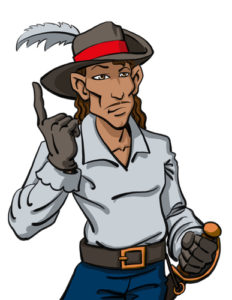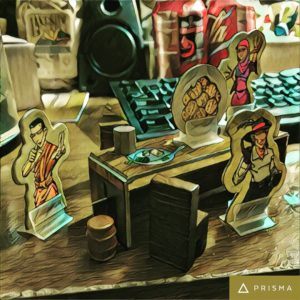I first mentioned Dragon & Flagon in my Gen Con preview, declaring it the unofficial official InnRoads Ministries mascot game. There was never any doubt that I’d own a game about a medieval fantasy tavern where heroes do battle on a three dimensional board for honor and bragging rights. When it arrived and I saw a man swinging from the chandelier over a room filled with rowdy onlookers, I leapt to my calendar.  There were days to go before I could rally enough people to maximize the eight person player count, but – in spite of that – I opened up the baggies and popped the cardboard with zeal.
There were days to go before I could rally enough people to maximize the eight person player count, but – in spite of that – I opened up the baggies and popped the cardboard with zeal.
I’m not so proud as to deny that I giggled when the pieces locked together forming the the tables, nor will I hide the fact that I held out the wooden furniture pieces to my wife and said, “Look! Little chairs!” I may be a full grown man, but I am not above reveling in the simple joys of life. In a way, I reverted to my little kid self on Saturday morning. I couldn’t wait until we could be throwing mugs and pushing tables. Couldn’t wait until I pushed a barrel into somebody after they bonked somebody with a hammer. I had opened an invitation to take part in a cartoon!
While I’ve seen some companies choose a cartoon-like style before, it doesn’t always fit the game. As much as I love the game, for instance, I still cringe when certain monster cards are flipped over in my game of Cutthroat Caverns. However, with Dragon & Flagon, I think the game would be sorely lacking if it chose to do anything else. If this game decided to go for a more realistic style, or even one like that of the fantasy games it draws its characters from, the entire tone would shift. The game hinges on the fact that you are a bunch of adventurers blowing off steam at the tavern before or after the big quests unfold. You aren’t looking to take anyone out, as there isn’t player elimination in the game. You’re just looking to prove that you’re the more heroic hero. The bright and colorful images with the heavy outlines didn’t distract or take away from the character design. They were all unique and diverse, but yet it was still clear who everyone was. The rogue, the mage, the cleric, the monk. Each of them were partying at the Dragon & Flagon, and I wanted to try them all.
 There’s no more perfect example of the games light-hearted intentions in my mind than Montero the Swashbuckler. Puffy shirt aside, Montero’s move set includes things like “Witty Retort” – whose card features the hero sticking his tongue out to at his foes and an encouragment in the rule book to come up with an actual bon mot [their words, not mine]. There’s also “Wave of the hat” – where he literally takes off his white-plumed chapeau and smacks people with it. This game may be a programming game where you are trying to figure out which cards to play when to maximize their effectiveness next turn, but it’s also a game where you can throw a little wooden mug at someone before getting on the table to brag about how many goblins you killed last week. The art style matters because this game is at its best when it isn’t like a cartoon, but actually is a cartoon!
There’s no more perfect example of the games light-hearted intentions in my mind than Montero the Swashbuckler. Puffy shirt aside, Montero’s move set includes things like “Witty Retort” – whose card features the hero sticking his tongue out to at his foes and an encouragment in the rule book to come up with an actual bon mot [their words, not mine]. There’s also “Wave of the hat” – where he literally takes off his white-plumed chapeau and smacks people with it. This game may be a programming game where you are trying to figure out which cards to play when to maximize their effectiveness next turn, but it’s also a game where you can throw a little wooden mug at someone before getting on the table to brag about how many goblins you killed last week. The art style matters because this game is at its best when it isn’t like a cartoon, but actually is a cartoon!
If you grew up, as I did, with a penchant for older movies featuring the versatile comedic genius of Mr. Danny Kaye, there is a bit of impossible dialogue that probably started rattling around in your head the moment you saw this game or read the title of this article. The performance I’m talking about is in the film The Court Jester, where he plays the titular role.
Danny Kaye’s character is about to enter a duel to the death with a fearsome warrior. He’s hopelessly outmatched, but his friends plan on poisoning the other man at the traditional toast before the match. All of this sounds gruesome and like something out of a Game of Thrones episode more than a comedy. That is until you see how it plays out. You see he has to remember which of the two glasses has the poison in it. It is important that he remember that the pellet with the poison’s in the flagon with the dragon. The vessel with the pestle is the brew that is true. You can probably guess that hilarity ensues. And that’s not even mentioning the fact that his armor is struck by lightning, causing it to be magnetized – naturally. I have to believe that the game takes at least some inspiration from that scene, and it fits – taking something that would be horrible and terrifying and turning it into a prat-falling comedy act
 This game was everything I needed, even though I didn’t know I needed it. It was fast paced, it was easy to learn, the characters seemed powerful and their moves made sense. Programming style games can be infuriating, but this made it hilarious. The three dimensional aspect of literally pushing tables and pulling rugs was a tactile dream, and every one of my players asked when we could play it again.
This game was everything I needed, even though I didn’t know I needed it. It was fast paced, it was easy to learn, the characters seemed powerful and their moves made sense. Programming style games can be infuriating, but this made it hilarious. The three dimensional aspect of literally pushing tables and pulling rugs was a tactile dream, and every one of my players asked when we could play it again.
By the time we were done, I wanted to drink deep from the Dragon Flagon and forget about the weight I carried. We often talk about weighty stuff on here with our exploration of our games, viewing them exegetically to discover some universal truth. But not here. In that moment at the table I wanted to be silly, and ridiculous, and embrace that I had been dazed for the past four turns and had no idea what the cards I was playing actually were.
I desperately needed to feel the anticipation of playing the cleric’s dragon attack just so I could shout, “It’s time I took y’all to CHURCH!” I needed to embrace the madness and let the game remind me about having fun for the sheer joy of having a good time with friends old and new. I needed a game that may as well have ended with the The Merry Go Round Broke Down playing and Montero coming out of the bar with a black eye to produce the Dragon Flagon from his hat saying “That’s All, Folks!” And in a way, there’s nothing more beautiful that I can ask a game to do.





Okay, I need to own this game. My game group is a very non-competitive bunch–having fun is way more important than who wins. This sounds perfect. Plus, I totally caught the reference of the article title.